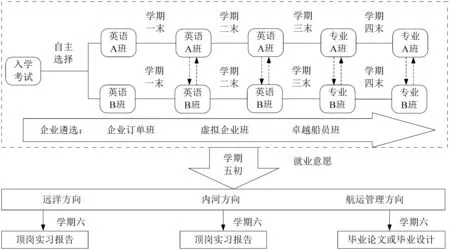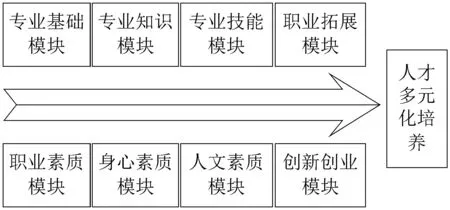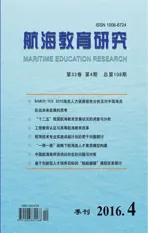现代职教视阈下航海人才多元化培养模式构建
2016-12-21完剑侠缪克银黄锦鹏丁振国
完剑侠,缪克银,黄锦鹏,丁振国
(江苏海事职业技术学院,南京 211170)
现代职教视阈下航海人才多元化培养模式构建
完剑侠,缪克银,黄锦鹏,丁振国
(江苏海事职业技术学院,南京 211170)
面对国家发展绿色海运和推进21世纪“海上丝绸之路”建设对高素质航海人才的需求,以因材施教为原则,从培养目标、培养模式、课程体系、教学方法等方面探索专业教育与素质教育的融合,开展航海人才多元化培养实践。以满足行业发展和学生个性化需求,培养“有宽度、有厚度、多层次”航海人才,服务国家海洋强国战略和“一带一路”战略。
航海职业教育;多元化培养;现代职教
一、引言
海运是全球经济发展的重要保障,占国际贸易货运总量的2/3以上,我国绝大部分进出口货物都是通过海洋运输方式实现的。2014年9月,《国务院关于促进海运业健康发展的若干意见》确立了到2020年基本建成安全、便捷、高效、绿色、具有国际竞争力的现代海运体系,以适应国民经济安全运行和对外贸易发展的需要。
我国航海高等职业教育历经几十年的发展取得了显著成绩,中国已成为世界海员大国。然而,在航海人才的培养上,我国高等职业教育仍然存在着不少的问题。一方面,国内生源数量的持续减少,使得航海高等职业院校的生源质量逐年下降,对航海人才专业能力的培养提出了巨大挑战;另一方面,航海高等职业院校长期围绕国家海事局船员适任证书考试开展专业教育,形成了重视专业理论轻视素质教育的固化模式,学生综合能力普遍不高,创新创业能力薄弱,职业晋升与拓展受到了很大的限制。此外,航海高等职业教育人才培养规格与标准过于单一,专业口径狭窄,人才培养的广度与深度不够,难以满足行业对复合型人才的需求。总体而言,航海高等职业教育与国家海洋强国战略的人才需求还存在着较大差距。
2014年6月,国务院印发了《关于加快发展现代职业教育的决定》,加快发展现代职业教育成为我国高等教育的一项重大战略部署。决定的核心是培养更多高素质劳动者和技能型人才,未来职业教育的规模要达到高等教育规模的一半以上,中高职衔接、学历教育、终生教育将成为高等职业教育的重要形式。面对现代职业教育生源的多元化和教育重心的下移,单一的人才培养模式与路径显然已难以适应职业教育理念的转变。
因此,全面推进多元培养模式的改革与创新,培养“有宽度、有厚度、多层次”的航海人才,实现航海高等职业教育从规模发展向内涵建设的转变,是现代职业教育体系下人才培养的客观需要,也是大力发展绿色海运和推进“21世纪海上丝绸之路”建设的必然要求。
二、多元培养目标定位
合理的培养目标是实现人才培养的关键,也是高等职业教育的出发点和归宿,它包括高等职业院校学生培养的基本方向定位,以及由此决定的学生在接受完高等职业教育之后在知识、能力和素质方面达到的规格要求[1]。面对工业4.0时代复合型人才的需求,改革人才培养模式,实施多元化培养是提升人才培养质量的重要途径。
多元培养一是培养目标的多元化。根据学生的个体差异和就业意愿,实施“分层分类”培养。一方面,结合船舶“大型化、高速化、现代化”的特点,进一步细化岗位分类,实施更加专业的教育,将部分学业水平高、综合素质好、专业稳定性强的航海人才推向国际市场;另一方面,强化专业技能教育,培养沿海、内河高素质船员,迎合国家“推动长江经济带发展”战略需要;同时,打通航海技术专业群,实施跨专业教育,培养具备航海专业知识的航运管理人才,实现学生的多元成才。
多元培养二是培养方式的多元化。结合现代职业教育的特点、目标要求和“90后”学生的个性需求,从“以人为本”的角度出发,改革人才培养模式,寻求当代大学生知识、技能获取途径与素质提升的多样化创新。实施专业教育与素质教育的“双线并举”,培养兼具专业技术能力、外语应用能力、人际交往能力、团队管理能力、决策与领导能力、身心素质和人文素质等,能胜任海、陆两个方向多岗位的复合型航海人才。
三、多元培养模式设计
在人才培养上,除了从办学师资、办学条件、办学资源、办学经费等方面进行研究与建设外,以人才培养模式为核心,多元课程体系和素质教育为两翼,教育教学模式创新为载体(见图1),实施人才培养的软环境建设,对于提升人才培养质量有着重要意义。

图1 多元人才培养模式构建
人才培养模式是指在某一(些)教育理论、教育思想的指导下,按照预定的人才培养目标与规格,以相对稳定的教学内容、管理制度和评估方式实施教育的过程。人才培养的前提是要尊重个体差异,满足学生的多样化需求。根据学生的认知水平、学习能力以及兴趣爱好,将学生区分成若干层次和类别,针对不同层次和类别的学生,在教学内容和教学方法上有所区别、有所侧重,给予学生更多的自主选择权和更大的发展空间,实现不同层次的学生都尽可能得到发展。[2]
1.实现多元成才关键是建立对应的课程体系
课程体系是基于人才培养模式将不同课程按照某种顺序进行排列,而课程的门类和排列顺序决定了学生通过学习将掌握的知识与获得的能力。[3]改革教学内容,重建课程体系是实现高等教育目标多元化的重要途径。通过建立专业教育与素质教育“双线并举”的多元化课程体系,实现课程结构的多元化和课程类型组合的可选性,建立“专业+素质”多选择性课程模块,学生根据自身爱好和就业方向进行课程选择,以第一课堂、第二课堂等多种教学形式实施多元培养。
2.实现多元成才的重要途径是实施素质教育
高等职业教育在传授专业技能的同时培养学生综合素质,是社会对复合型人才的基本要求。航海职业的“国际性”需要学生具备很高的综合能力,而航海类专业“技术应用型”的岗位特点要求学生具备较强的创新精神与创新能力。第二课堂教育作为素质教育的重要载体,充分发挥其功能引导和组织学生开展的各种有意义、健康的课外活动,推进课内教学与课外教育相融合、素质教育与职业教育相融合、理论学习与实践学习相融合,是学生能力与素质同步提升的重要保障。[4]航海职业教育在专业教育基础上,转变教育思想,更新教育观念,调整人才培养方案,寻求创新创业教育与专业教育的相互融合,培养学生的创新精神与创新能力,是提升航海人才培养质量的重要途径。此外,进行国内外合作交流是增加航海教育供给侧多样性和选择性的重要手段。通过合作与交流,改变航海类学生接受教育的条件与环境,拓展学生的专业和国际化视野,可有效提升人才培养的宽度。
四、多元培养模式实践
1.“分层分类”的人才培养模式
(1)采用“项目+项目”人才培养方式,根据学生能力水平实施课程分层教学。依据学生兴趣爱好实施专业方向分类培养。
在人才培养方案中适度增加英语教学课时,通过英语入学考试,在一、二学期实施A、B、C三个层次的英语分层次教学,设置适合不同英语基础的教学计划与教学进度,根据学生期末成绩对学生层次进行动态调整;在三、四、五学期根据细化的专业方向,重新架构课程内容实施专业英语的分层培养。
在人才培养方案中设置专业方向课,第四、五学期,在专业通识教育的基础上打通专业群课程,实施学生分类培养,远洋方向注重英语强化,设置国际贸易与法规类课程;沿海方向注重专业基础能力提升,设置货物运输和内河航运类课程;陆上方向注重能力拓展,消减专业课程,增加部分水运管理类课程。对不同就业方向的学生采取实习报告、毕业论文和毕业设计等多种形式的毕业实习考核。
(2)结合岗位需求,实施通识教育与精英人才的差异化培养。设立企业订单班、企业虚拟学院,并结合现代航运对高素质复合型人才的需求试点“卓越航海”计划。
企业订单班,主要根据企业个性化需求,调整专业课程设置,增加不同航运形式的专业课程和英语口语等课程,邀请企业人员参与课程教学。虚拟企业学院主要以“校企共同投资、虚拟学院实体运作、双主体联合实施”为原则,由校企双方共同制订人才培养方案、共同开发教学资源、共同招生、共同培养,实现企业需求与人才培养的无缝衔接。“卓越航海”则以国际化人才为培养目标设置人才培养方案,建立以国际标准为要求,培养出具有较强英语应用能力、创新能力、实践能力、国际竞争力、职业拓展能力、职业稳定度高的航海精英人才(见表1、图2)。

表1 差异化人才培养路径表

图2 “分层分类”培养示意图
2.“双线并举”多元化课程体系构建
在专业课程体系的构建中,选取“模块化”构建模式对专业课程内容进行重新梳理与构建。将职业能力拆解为82个单元,建立对应知识点的17门课程,再由若干门课程组成对应一项工作任务的12个课程模块,并将内容较为复杂课程拆解成2个学期,提供不同专业方向的学生进行课程选择。专业课程体系突出技能培养,实践教学课时比例达到60%以上。同时,为拓展专业外延,增加了职业能力拓展模块,打通专业群课程,将部分水运管理的专业课程作为选修课对航海类专业开放。
教学方法与教学资源是教学过程的有机组成部分,是人才培养模式和目标实现的重要载体。在专业课程体系构建中,以“工学结合”为原则,重新编写课程的“项目化”教材。在课堂教学上利用现代信息教学手段、虚拟仿真和理实一体化教室,以任务为驱动实施“项目化”教学,对部分课程开展“翻转式”“体验式”教学改革。通过引进并自主开发在线开放课程,建设覆盖主干课程的微课程群和教育教学资源库,实施校内开放的“线上线下”互动教学。从而推进“以教为主向以学为主、以课堂教学为主向课内外结合、以结果评价为主向过程结果相结合评价”教学形式的转变,实现人才培养过程的多元化。
在素质课程体系的构建中,建立职业素质模块、身心素质模块、人文素质模块和创新创业素质模块。增加社会实践(服务)类课程,将学生活动和社会实践以学分认定的形式纳入人才培养方案中。注重丰富人文艺术类和综合素质类的选修课程类别,在校期间要求学生至少完成4个学分的课程学习。将创新教育纳入课程体系,组织企业和专业教师合作开发具有航海特色的创新课程。
针对不同的分类方向,实施弹性学分制,允许学生根据自身需求进行课程选择,建立专业教育与素质教育“双线并举”适合“分层分类”培养的多元选择课程体系(见图3)。

图3 “双线并举”多元选择课程体系
3.素质教育的实施
(1)第二课堂功能的发挥。发挥“团学”组织功能,以共青团和学生社团活动为切入点,创新具有航海特色的校园文化和社团活动,推进素质教育与职业教育的相互融合。发挥企业在人才培养中的作用,企业作为人才吸纳的主体,对于人才应具备的能力和素质具有最优先的发言权。[5]通过引导企业参与人才培养,实施“船长领航、共育人才”计划,聘请企业一线骨干担任兼职班导师,从航运发展、企业需求,行业实践、职业规划等多方面开展常态化指导。
(2)创新创业教育的开展。明确航海人才创新创业教育目标,构建以创新精神、创业意识和创新创业能力为指标的学生创新创业评价体系,并纳入教育评价方案。广泛邀请教育专家和创新创业典型参与学生创新创业教育,以教师创新能力提升为载体,推进学生创新创业教育与专业教学的相互融合。借助开放性训练室,搭建创新创业平台,建立大学生实践创新工作室。建立学分兑换机制,激励学生参加企业实践、省级和国家级职业院校创新创业竞赛和技能大赛,以提升学生的创新创业能力。
(3)合作交流的实施。通过与境外航海院校的交流合作,建立师生常态化互访、学分互认、人才共育的培养机制,形成国际合作教育平台,实施人才的国际化培养。借力企业订单班、企业虚拟学院等校企合作模式,与企业共同开发专项培训项目,建立学生职业生涯规划与企业发展的有机融合,实现学生专业能力与综合素质的双提升。同时,与国内航海本科院校探索开展高职本科衔接项目人才培养,打通专科学生的毕业升学渠道;与国内同类航海院校开展师生交流,实现航海教育理念和教学资源的交流共享。
五、结语
实施多元化培养,从知识与素质两个方面构建不同层次和能力水平的复合型航海人才,使其结构、规模与经济社会发展更加匹配,进一步满足社会发展与行业需求,是现代职业教育功能发挥的重要体现。实施人才多元化培养模式改革是航海职业教育发展的必然趋势,也是推动实施“海洋强国”战略人才需求的重要保障,对于打造航海教育品牌,培养具有国际竞争力的航海人才具有重要意义。
[1]阎威,韩雁,梁志星.高等院校改革背景下多元化人才培养模式的探索[J].教育与职业,2013(32):16-19.
[2]张德高.分层分类视域下的高校人才培养策略[J].教育发展研究,2013(19):77-79.
[3]陈桂云,戴存礼.面向学生发展的多元化大学课程体系构建[J].中国农业教育,2014(5):25-30.
[4]魏培徵,马化祥,马莉萍.高校第二课堂与大学生创新素质培养的关系研究[J].思想教育研究,2011(10):99-103.
[5]周美兰,戈宝军,孟大伟.电气工程及其自动化专业多元化人才培养模式的探索[J].中国电力教育,2007(11):53-55.
*收稿日期:2016-10-20
作者简介:Capt. Alexander Gorobtsov, Director of Maritime Academy, Admiral Makarov SUMIS, St.Petersburg, Russia.
1. Introduction
The application of e-learning and distance education technologies in International Maritime Education and Training (MET) Institutions takes one of the most important places in the education process organization. This is, partially, due to the fact that using Internet as the education process addition is necessary for a quick data search, professors’ and students’ communication and their resources outreaching as well.
2. The world experience of e-learning and distance education technologies
According to various researches, International MET Institutions, including those that are specialized in training seafarers and are reported to be official members of the International Association of Maritime Universities (IAMU), have been using the e-learning and distance education technologies for a long period of time: 7-10 years on the average or more than 15 years in some cases.
The e-learning and distance education technologies are used in different levels of MET. Generally they are applied for advanced professional training. High and higher education programs apply the e-learning and distance education technologies as an addition to the traditional MET.It is necessary to point out that there is a national list of professions, issued by the Russian Federation Ministry of Education and Science Order No.22, dated January 20th, 2014, whose ET programs are restricted to accept education solely provided by e-learning and distance education technologies. Actually, this fact prevents the e-learning and distance education technologies from being applied to ET programs on designated professions.[1]
To carry out the e-learning and distance education technologies education process, it is essential to use program—technical, technological and telecommunication aids.
Original aids of the e-learning and distance education technologies are considered to be Learning Management System (LMS), Learning Content Management System (LCMS). Such an advanced type of systems let not only the course general information be available, but also the lectures, seminars and webinars, courses, tests and examinations be hold online. The most widely-used technology is LMS—Moodle, Blackboard, etc. are based on.
Sometimes MET Institutions use several program platforms to have the education process conducted as Moodle, Blackboard, Sakai, Canvas, edX, Coursera and others, including own platforms, for example.
Figure 1 shows that Moodle LMS is widely used by 27% of the observed MET Institutions. Looking from the geographic point, this platform is mostly installed in Eastern Europe and much less in Asia, Africa and America.

Figure 1 The application of e-learning and distance education technologies in MET Institutions
Approximately 30% of MET Institutions design their own education and training applications and distribute it free of charge in Internet-shops for iOS or Android operational systems. MET Institutions issue training materials in e-libraries as well as in universal applications such as iTunes U (iTunes U appears to be the most prominent online catalogue of free-of-charge books all over the world). To store and distribute lecture, conference and practical training video-materials, MET Institutions have got used to making up their own channels at video-hosting, such as Youtube, Wikimedia Commons, Vimeo.com, Flickr, to let various materials be available for free.
3. The legal background of E-learning and distance education technologies
The core legal document in Russia for the appliance of e-learning and distance education technologies by MET Institutions is considered to be the State Law No.273—SL on “Education in Russian Federation”, issued—December 29th, 2012[2]. This bill stands for public relations, appearing to exist within education process, when people use their right to get education. Moreover the document determines the legal status of education process participants and establishes the economic, legal and organizational basis of education and training in the Russian Federation as well. Also the document fixes the rules/the order of both the educational system and the educational process to carry out.
Not only this, but also the state education standards and the legal documents of Russian Federation Ministry of Transport and Ministry of Education and Science fix the observed problem. For example, Ministry of Education and Science Order No.2, dated January 9th, 2014, “On assertion of the e-learning and distance education technologies order of application by MET Institutions”[3].
The major paper, concluding international standards on training, certification and watchkeeping for seafarers and providing the points that stand for requirements to the proper level of seafarers’ education and training as well as their sufficient experience and skills, is the International Convention on Standards of Training, Certification and Watchkeeping for Seafarers. Also the document reveals out the points that stand for the necessity of seaferers’ coincidence with the requirements to their work, age, health condition and their ability to cope with their duties the way, essential for human life and property safety in the sea and sea environment protection as well[4].
The STCW Convention admits the application of e-learning and distance education technologies within the education process of seafarers, according to training and evaluation standards.
4. The example of the LMS “FARWATER” compliance to training and competency evaluation standards of the STCW Convention
There has been applied LMS “FARWATER” to carry out educational and training programs in Admiral Makarov SUMIS with application of distance educational technology. The system is based on Moodle platform, which is considered to be a system to manage education process. The full title is Modular Object-Oriented Dynamic Learning Environment.
Table 1 presents the correspondence of our distance learning system LMS “FARWATER” capacity to STCW Code guidance.

Table 1 Correspondence to STCW Code
5. Analysis and discussion
Authors believe distance learning system is a smart and useful tool for upgrading seafarer’s competency. More discussion requires questioning whether LMS or similar system can be effective in simulator training, are there limits for virtual simulators to serve as analog of existing computer based simulators, how we can tie it with STCW requirements.
6. Conclusions
In conclusion, it is essential to mark out that at present Admiral Makarov SUMIS obtains initial experience of LMS implementation. It clearly shows preferences of vocational training in a distance learning environment and convenience of LMS “FARWATER” for trainees (according to feedback reports). It was also recommended by first groups of trainees to add more reference materials, adjust or reduce some sections or even certain lectures for better understanding and time saving. Needless to say, all feedback reports were positive.
Admiral Makarov SUMIS has a serious plan for expansion of distance learning program range. Our strong base is commitment to rather conservative approach keeping harmony between variety of courses delivered and traditional high quality of education and training.
[1] Minobrnauki RF Order of 20.01.2014 N 22 (update of 10.12.2014) “On adoption of nomenclature of professions and specialties of high professional education which cannot be provided solely in a form of electronic education and/or distance educational technology” (Ministry of Law Registry, 21.02.2014 N 31377).
[2] Federal Law of 29.12.2012 N 273-ФЗ “On education in the Russian Federation”. Consultant.ru: online reference system URL[EB/OL].(2015-07-13): http://base.consultant.ru/cons/cgi/online.cgi?req=doc;base=LAW;n=182943.
[3] Minobrnauki RF Order of 09.01.2014 N 2 “On adoption of regulation of distance learning for educational organizations based upon electronic education, distance learning educational technology during education process” (Ministry of Law Registry, 04.04.2014 N 31823).
[4] IMO. STCW Convention 1978 and the STCW Code as amended.
The Application of E-learning and Distance Learning Technologies to Crew Education and Training in the Russian Federation
A. Gorobtsov, N. Kovalnogova, S. Kurguzov, V. Marich, S. Sokolov
(Admiral Makarov State University of Maritime and Inland Shipping, St.Petersburg, Russian Federation)
The article examines the world experience of e-learning as well as distance education technologies within the education process organization on higher and post-higher education programs. There have been listed the results of the most popular e-learning platforms analysis. Furthermore, there have been looked through the core legislative background of the development of the mentioned technologies in Russia and worldwide among the universities, specialized in seafarers training. There have been also drawn up the points of the Admiral Makarov State University of Maritime and Inland Shipping (Admiral Makarov SUMIS) design of the distance education system LMS “FARWATER” in compliance with the International Convention on Standards of Training, Certification and Watchkeeping for Seafarers (STCW Convention). The practical application of distance education system to the advanced professional training has been discussed in the article.
e-learning, distance learning technologies, MET Institutions, advanced education platforms, distance education system, seafarers training, International Convention on Standards of Training, Certification and Watchkeeping for Seafarers
2016-06-01
江苏省高校品牌专业建设工程资助项目(PPZY2015B177)
完剑侠(1983-),男,讲师,主要从事航海职业教育研究。
G710
A 文章编号:1006-8724(2016)04-0036-05
� 文献标识码:A
1006-8724(2016)04-0041-06
